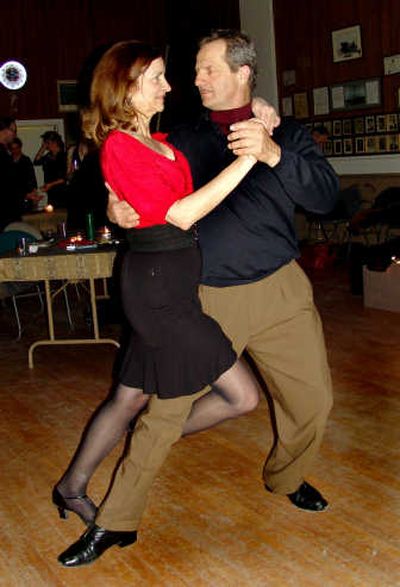Warm up cool nights with a tango

The newspaper calendar item was intriguing: “Argentine tango dance, 7 to 9 p.m. … at the VFW Hall in Coeur d’Alene.”
And, such a wintry night it was. One must wonder what kind of madness would lure normally sane people out on a snow-filled night like this, even from Spokane and Sandpoint?
It must be Argentine Tango Madness.
“Milonga,” read the sign on the door. Inside, in the darkened ballroom, the only illumination came from candle torches around the edge of the room. Leaping up from the torches were long, wildly flickering flames that seemed to dance in rhythm with the sultry and evocative music filling the room. This strange, ethnic-sounding music was multilayered – an exotic blend of the sweet sounds of the violin, an impetuous flamenco guitar and the mournful sounds of the essential bandoneon, an accordionlike instrument.
The Milonga dancers were in a close embrace, dancing cheek-to-cheek. Some had their eyes closed as they moved together, smoothly and precisely in rhythm with the music. The atmosphere was pensive and subtle; the music heady, provocative and seductive.
The scene was utterly captivating and one which conjured up visions of an earlier time of slicked hair, entwined legs, lithe movements, slinky dresses, cigarette holders, and smoky nightclubs in Buenos Aires, Paris, Casablanca or Miami – jammed with sophisticated, self-absorbed dancers and, of course, the very suave Rudolph Valentino.
But suddenly, there was a squeak in the lovely but well-used, 80-year-old wooden dance floor, interrupting the melancholy thoughts, and it was once again February 2008, and Tango Tuesday at the VFW in Coeur d’Alene.
Robin Campbell, who lives in Sandpoint where she owns two retail boutiques, is the co-founder/coordinator of Tango Tuesday. She said, “The Argentine Tango is an intimate conversation between two dancers, a lead and a follow, under the umbrella of rich, passionate, emotion-filled music. Unlike the showy, American style tango, the Argentine tango is just for the couple; any ‘showing off’ in this tango would be in the execution of smooth, precise and subtle movements.”
She’s right. There is nothing of the tango we Americans so readily recognize – swirling dancers with arched backs, looking over their shoulders, executing deep dips and showy moves – the tango made famous by dance studios, stage shows and movies. That tango offered a lot of flash but not much heart.
“Because the dancers are so focused on the rhythm, the music and on their physical communication, one might compare this dance to transcendental meditation, where the music is the mantra,” Campbell added.
The birth of the Argentine tango took place in the dark, immigrant corners of Buenos Aires in the late 1800s, when European immigrants were flooding into the Americas, including Argentina, by the millions. Spaniards, Italians and other ethnic groups came to Argentina bringing with them their polkas, waltzes, mazurkas, and schottisches.
This influx of cultures jumped into the already rich mix of Argentina’s newly freed African slaves, the Argentine gauchos and Cuban habaneras – people who had themselves recently migrated into Buenos Aires and its outskirts. Each ethnic group carried within their hearts and souls, the imprint of their own native music and dance. Inevitably there was a dynamic blending of these diverse but raw and powerful cultural imperatives.
Imagine the mix. Musicians always seem to find each other, play each other’s music and become influenced by their vastly different styles and sounds. We can only imagine the music emanating from the Argentine barrios (neighborhoods), bars and brothels – sometimes called Academies de Dance – and other places that became fertile breeding grounds for this unique, expressive and evocative music and dance, a blend like none other.
The Argentine tango was thus spawned. At first, the dance was viewed as scandalous and rejected by the elite of Buenos Aires as a dirty, street dance. However, the young, affluent gentlemen would flock to the “Dance Academies” for instructions on this tango.
Eventually the scandalous tango, and its many ethnic variations gained respectability, even becoming a craze. In the 1920s, the tango was popularized by Hollywood’s Latin Lover, Rudolph Valentino, and tango madness caught on in America, too.
Longtime tango aficionados agree the Argentine tango we see today originated in Buenos Aires around 1938 or 1940, likely by the immensely popular tango singer, composer and musician, Carlos Gardel. The belief is widely held that Cardel’s influence heralded the start of the international Golden Age of Tango, a period lasting until early 1950.
Although the Argentine tango is not currently mainstream, it does have a niche following in major cities. George Minas of Coeur d’Alene, and a member of the Tango Tuesday group, was surprised to find an Argentine tango dance venue on a recent trip to Sofia, Bulgaria.
Minas smiles and answers softly when asked what draws him to this dance, “It’s the music, the atmosphere, the ladies … the whole thing.” Minas has even flown to Buenos Aires for advanced lessons and to practice with Argentineans.
Another couple at the Milonga that evening was Tim Savatieff and Alyson Roby, of Valleyford, Wash. They just returned from a two-month vacation in Buenos Aires, where they took tango lessons by day and danced every night at one of the 30 Milonga venues (many with live music) offered throughout the city.
The basics of the Argentine tango are simple, but not easy to learn. It takes a bit of dedication to make these basics second nature. Beyond the basics, it is a dance of smooth, walking moves, and steps offering infinite opportunities for innovation.
The Argentine tango is a very macho dance and it appeals greatly to both men and women. “If you can walk, you can tango,” promises Paul Pellicoro, a master Argentine tango teacher who deserves some of the credit for new stirrings and a possible resurgence of tango madness in our land.